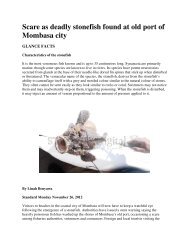Experimental Polyculture of Milkfish (Chanos chanos) and Mullet ...
Experimental Polyculture of Milkfish (Chanos chanos) and Mullet ...
Experimental Polyculture of Milkfish (Chanos chanos) and Mullet ...
You also want an ePaper? Increase the reach of your titles
YUMPU automatically turns print PDFs into web optimized ePapers that Google loves.
Western Indian Ocean J. Mar. Sci. Vol. 10, No. 1, pp. 59-71, 2011<br />
© 2011 WIOMSA<br />
<strong>Experimental</strong> <strong>Polyculture</strong> <strong>of</strong> <strong>Milkfish</strong> (<strong>Chanos</strong> <strong>chanos</strong>)<br />
<strong>and</strong> <strong>Mullet</strong> (Mugil cephalus) Using Earthen Ponds<br />
in Kenya<br />
David O. Mirera<br />
Kenya Marine <strong>and</strong> Fisheries Research Institute, PO Box 81651-80100, Mombasa, Kenya.<br />
Keywords: polyculture, milkfish, mullet, earthen ponds.<br />
Abstract—Seasonal growth <strong>of</strong> milkfish (<strong>Chanos</strong> <strong>chanos</strong>) <strong>and</strong> mullet (Mugil<br />
cephalus) was studied in polyculture in six small earthen ponds in Mtwapa Creek <strong>and</strong><br />
Gazi Bay, Kenya, between 2005 <strong>and</strong> 2006. The ponds were sited on s<strong>and</strong>y mangrove<br />
flats <strong>and</strong> were periodically connected with the sea providing water exchange during<br />
high spring tides. This inundation also filled mangrove pools <strong>and</strong> channels where<br />
fish fingerlings <strong>and</strong> juveniles were seined with push nets to establish their seasonal<br />
abundance <strong>and</strong> to stock the ponds. Fingerlings weighing 5-9 g were stocked at 4 fish/<br />
m 2 <strong>and</strong> a polyculture ratio <strong>of</strong> 5 milkfish: 1 mullet. The ponds were fertilized with<br />
dry chicken manure at 15 kg/pond every two weeks (0.595 g/m 2 per day). Fish were<br />
sampled monthly, basic water quality parameters (temperature <strong>and</strong> oxygen) were<br />
monitored weekly <strong>and</strong> nutrient analysis four times per crop. There were significant<br />
differences in milkfish <strong>and</strong> mullet abundance between months (p
60 DAVID O. MIRERA<br />
Mariculture in East Africa is still small<br />
in scale <strong>and</strong> undeveloped (Bryceson, 2002)<br />
compared to South East Asia where it forms<br />
the backbone <strong>of</strong> the economy. Finfish culture<br />
has focused on the culture <strong>of</strong> milkfish, mullet<br />
<strong>and</strong> rabbit fish, with the latter being less<br />
tolerant to sudden changes in environmental<br />
parameters (Mmochi & Mw<strong>and</strong>ya, 2003).<br />
<strong>Milkfish</strong> <strong>and</strong> mullet always occur together in<br />
coastal wetl<strong>and</strong>s; they consume similar food,<br />
mainly the abundant detritus, i.e. lab-lab<br />
(benthic algal mat) <strong>and</strong> lumut (filamentous<br />
algae) which create a complex community<br />
structure (Bagarinao, 1999).<br />
<strong>Milkfish</strong> farming in East Africa <strong>and</strong> parts<br />
<strong>of</strong> Asia is quite extensive in small ponds<br />
0.5-1.0 m deep depending on tidal water<br />
exchange, using natural food, a minimal<br />
use <strong>of</strong> fertilizers <strong>and</strong> a low stocking density<br />
(2-3 fish/m 2 ) (Mmochi & Mw<strong>and</strong>ya, 2003;<br />
Bagarinao, 1999). Over the past few years in<br />
Kenya, milkfish <strong>and</strong> mullet culture has been<br />
practised in pens enclosing natural channels<br />
<strong>and</strong> pools (Mwaluma, 2003; Rasowo, 2004).<br />
<strong>Milkfish</strong> <strong>and</strong> mullet polyculture constitutes<br />
a recent introduction (6 years) to maricultural<br />
research in Kenya, but it has a longer (10 years)<br />
history in Tanzania (Mwangamilo & Jiddawi,<br />
2003). This polyculture is considered suitable<br />
for mariculture due to the tolerance <strong>of</strong> milkfish<br />
<strong>and</strong> mullet to varied levels <strong>of</strong> oxygen <strong>and</strong><br />
salinity (Mmochi & Mw<strong>and</strong>ya, 2003; Smith &<br />
Heemstra, 2003), a common characteristic in<br />
intertidal earthen ponds used for aquaculture<br />
where water exchange is dictated by the tidal<br />
regime.<br />
In South-east Asia, milkfish have been<br />
grown in polyculture with mullet in marine<br />
coastal ponds due to their different feeding<br />
habits <strong>and</strong> habitat preferences (Joseph,<br />
1982; Lutz, 2003). The underlying goal <strong>of</strong><br />
milkfish <strong>and</strong> mullet polyculture involves<br />
increasing productivity, utilizing ecological<br />
resources within an aquatic environment<br />
more efficiently but with a reduction in risk;<br />
as mullet are susceptible to ectoparasites<br />
<strong>and</strong> scale loss (during h<strong>and</strong>ling) leading to<br />
secondary vibriosis, <strong>and</strong> mortalities (Tucker<br />
& Kennedy, 1998), in polyculture a farm is<br />
not dependent on this fish alone.<br />
This study was conducted to determine<br />
how wild milkfish <strong>and</strong> mullet fare in pond<br />
culture systems subjected to tidal water<br />
exchange with minimal organic fertilization,<br />
thereby depending on their natural<br />
productivity. Additionally, this study explored<br />
the influence <strong>of</strong> season (wet/dry) on growth<br />
<strong>of</strong> milkfish <strong>and</strong> mullet, <strong>and</strong> the availability <strong>of</strong><br />
fingerlings.<br />
MATERIAL AND METHODS<br />
Study area<br />
The study was conducted in intertidal earthen<br />
ponds in the mangroves <strong>of</strong> Mtwapa Creek<br />
<strong>and</strong> Gazi Bay, Kenya (Fig. 1), for 217 culture<br />
days. A total <strong>of</strong> six small earthen ponds (0.018<br />
ha each) were constructed on the intertidal<br />
mangrove s<strong>and</strong> flats during the dry season<br />
in 2005 <strong>and</strong> wet season in 2006. The dry<br />
season, when there was little or no rainfall,<br />
was June-December in 2005, while the wet<br />
season when rainfall was heavy in 2006 fell<br />
between February-August. Three sites were<br />
selected for this study along the coast <strong>of</strong><br />
Kenya <strong>and</strong> included the involvement <strong>of</strong> local<br />
communities: Kwetu Training Centre <strong>and</strong><br />
Majaoni Youth Group at Mtwapa Creek <strong>and</strong><br />
Makongeni Baraka Conservation Group in<br />
Gazi Bay (Fig. 1). Two ponds were used at each<br />
<strong>of</strong> the sites, their elevation varying between<br />
0.5 <strong>and</strong> 1.1 meters above mean sea level. The<br />
ponds at Mtwapa Creek had Avicennia marina<br />
at the upper, l<strong>and</strong>ward site <strong>and</strong> a mixture <strong>of</strong><br />
Ceriops targal <strong>and</strong> Rhizophora mucronata<br />
at the lower, seaward site, while those at<br />
Makongeni had A.marina at both sites. The<br />
Mtwapa Creek ponds were similarly located<br />
in an A.marina mangrove but the topography<br />
behind the ponds was relatively hilly relative<br />
to that at Makongeni where the topography<br />
had a gentler slope.<br />
Pond Design <strong>and</strong> Fertilization<br />
The culture ponds were constructed on s<strong>and</strong>y<br />
flats where seawater flow from the creek<br />
<strong>and</strong> bay could exchange up to 40% <strong>of</strong> the<br />
pond water every 10 days at high spring tide
<strong>Experimental</strong> <strong>Polyculture</strong> <strong>of</strong> <strong>Milkfish</strong> (<strong>Chanos</strong> <strong>chanos</strong>) <strong>and</strong> <strong>Mullet</strong> (Mugil cephalus) in Kenya 61<br />
Figure 1. Map <strong>of</strong> Kenya coast showing the study sites where polyculture trials were undertaken.<br />
through pond PVC overflow pipes (Fig. 2).<br />
Community aquaculture ponds in Kenya are<br />
only constructed on s<strong>and</strong> flats with minimal or<br />
no cutting <strong>of</strong> mangrove trees <strong>and</strong> no pumping<br />
systems for water exchange, unlike ponds in<br />
Southeast Asia where mangroves are <strong>of</strong>ten<br />
cut to create room for fishponds (Primavera,<br />
2005). The PVC overflow pipes were covered<br />
with screen nets on both sides to filter incoming<br />
<strong>and</strong> out flowing water <strong>and</strong> prevent entry <strong>of</strong><br />
predatory fish. They were fixed in the pond<br />
dykes one meter above the pond bottom to<br />
ensure retention <strong>of</strong> a minimum water depth <strong>of</strong><br />
0.75 m in the ponds at all times. The incoming<br />
tide enriched the culture ponds with plankton<br />
<strong>and</strong> nutrients from the ocean, aiding the<br />
development <strong>of</strong> the lab-lab (benthic algal mat)<br />
as a food source for the milkfish <strong>and</strong> mullet.<br />
Supplementary organic manure was used to<br />
fertilize the ponds at neap tide every fortnight.<br />
Dry chicken manure was obtained from local<br />
villages at $1 (70 kshs) per 30 kg sack. The<br />
manure was applied to the ponds at the rate <strong>of</strong><br />
15 kg per pond/2wks (0.595 g/m 2 /day). It was<br />
floated in sacks at the opposite corners <strong>of</strong> the<br />
ponds to enable slow release <strong>of</strong> the nutrients,<br />
thus promoting primary production while<br />
avoiding oxygen depletion. Old manure sacks<br />
were removed <strong>and</strong> replaced with new ones biweekly<br />
(Knud-Hansen, 1998).
62 DAVID O. MIRERA<br />
Figure 2. A pond at Majaoni showing the PVC<br />
st<strong>and</strong>pipe to drain the pond <strong>and</strong> the overflow pipe<br />
that allowed water exchange at spring high tides<br />
<strong>and</strong> maintained the water level.<br />
Water Quality Sampling <strong>and</strong><br />
Analysis<br />
Salinity, dissolved oxygen, temperature<br />
<strong>and</strong> pH were measured in situ in each <strong>of</strong><br />
the six research fishponds weekly, in the<br />
morning between 08.00-09.00 a.m. <strong>and</strong> in the<br />
afternoon between 14.00-15.00 p.m. using a<br />
h<strong>and</strong>-held refractometer, oxygen meter <strong>and</strong><br />
pH meter respectively. Samples for chl-a,<br />
ammonia, nitrite, phosphate, particulate<br />
organic matter <strong>and</strong> total suspended matter<br />
were collected monthly at three points in each<br />
pond in a plastic cylinder, mixed <strong>and</strong> then subsampled<br />
to obtain a representative sample for<br />
laboratory analysis. The samples were stored<br />
in cooler boxes with ice <strong>and</strong> transported to the<br />
laboratory at the Kenya Marine <strong>and</strong> Fisheries<br />
Research Institute (KMFRI) within three<br />
hours where analysis was done by titration.<br />
All water quality analyses were undertaken<br />
following guidelines outlined by Eaton et al.,<br />
(1995) <strong>and</strong> Boyd <strong>and</strong> Tucker (1992).<br />
Stocking <strong>and</strong> Sampling<br />
<strong>Milkfish</strong> <strong>and</strong> mullet fingerlings were collected<br />
to stock the ponds using push nets constructed<br />
with mosquito netting. Fingerlings were<br />
collected in mangrove channels <strong>and</strong> pools at<br />
low tide in the Mtwapa Creek <strong>and</strong> Gazi Bay.<br />
They were transported to the culture ponds in<br />
half-filled buckets with a 99% survival rate. The<br />
opportunistic capture <strong>of</strong> fingerlings in intertidal<br />
pools at low tide with h<strong>and</strong> nets also proved<br />
possible. Fish were corralled for 24 hours in<br />
a hapa (mosquito) net staked in the pond to<br />
enable their measurement (weight <strong>and</strong> total<br />
length) before stocking. The fish were weighed<br />
using a digital electronic balance <strong>and</strong> their<br />
length with a 30 cm ruler. Fingerling collection<br />
continued daily on average for 20 days to reach<br />
the required stocking density. A total <strong>of</strong> 392<br />
milkfish <strong>and</strong> 124 mullet were stocked per pond<br />
during each culture cycle, ranging between 2-8<br />
cm in length <strong>and</strong> 5-9 g in weight.<br />
Figure 3. Morning (08.00-09.00) <strong>and</strong> afternoon (14.00-15.00) variations in temperature in the fish culture<br />
ponds during the wet (long rains-2006) <strong>and</strong> dry (short rains-2005) seasons.
<strong>Experimental</strong> <strong>Polyculture</strong> <strong>of</strong> <strong>Milkfish</strong> (<strong>Chanos</strong> <strong>chanos</strong>) <strong>and</strong> <strong>Mullet</strong> (Mugil cephalus) in Kenya 63<br />
Figure 4. Growth <strong>of</strong> milkfish in coastal earthen ponds in Kenya during the wet season in 2006. Average<br />
growth rate was 0.53 g/day.<br />
Pond fish were sampled using seine nets<br />
once a month to measure their growth in both<br />
length <strong>and</strong> weight, sampling ~10 % <strong>of</strong> the<br />
total milkfish <strong>and</strong> mullet or 40 fish per pond.<br />
Harvesting took place after 217 days by draining<br />
all the water from the ponds through the outlet<br />
PVC pipes. Harvested fish were grouped<br />
Growth rate<br />
2.4<br />
2.2<br />
2.0<br />
1.8<br />
1.6<br />
1.4<br />
1.2<br />
1.0<br />
0.8<br />
0.6<br />
0.4<br />
0.2<br />
0.0<br />
<strong>Mullet</strong>-wet <strong>Milkfish</strong>-wet<br />
<strong>Mullet</strong>-dry <strong>Milkfish</strong>-dry<br />
Species/growing season<br />
into species <strong>and</strong> then into size classes before<br />
measuring their total length <strong>and</strong> wet weight. The<br />
harvest was sold to the local people at customary<br />
prices to create awareness <strong>of</strong> the importance <strong>of</strong><br />
mangrove conservation in providing livelihood<br />
opportunities such as fish culture.<br />
Mean<br />
SE<br />
SD<br />
Figure 5. Growth rate (g/day) <strong>of</strong> milkfish (<strong>Chanos</strong> <strong>chanos</strong>) <strong>and</strong> mullet (Mugil cephalus) in coastal earthen<br />
ponds in Kenya in the wet <strong>and</strong> dry seasons.
64 DAVID O. MIRERA<br />
Figure 6. Annual abundance <strong>of</strong> milkfish <strong>and</strong> mullet fingerlings in Mtwapa Creek in Kenya during 2005-2006.<br />
Fingerling occurrence survey<br />
Fingerling collection was based on the<br />
findings <strong>of</strong> Kumagai et al. (1985) who<br />
established that the occurrence <strong>of</strong> juvenile<br />
milkfish in natural mangrove nursery grounds<br />
(pools <strong>and</strong> channels) varied with the food<br />
supply, size <strong>of</strong> habitat <strong>and</strong> connection with the<br />
sea. Fingerling surveys were thus conducted<br />
twice a month in Mtwapa Creek during spring<br />
high tides. The fingerlings were collected in<br />
push <strong>and</strong> seine nets in the mangrove pools<br />
<strong>and</strong> channels that were connected with the<br />
sea during spring high tides. A crew <strong>of</strong> two<br />
undertook the sampling for a period <strong>of</strong> one<br />
hour in each sampling day. The fingerlings<br />
were identified <strong>and</strong> measured in the field <strong>and</strong><br />
transferred to ponds if needed for culture or<br />
released back to the sea.<br />
Statistical Data Analysis<br />
Arithmetic means <strong>and</strong> st<strong>and</strong>ard deviations<br />
were determined for the samples. One way<br />
ANOVA was used to assess the effects <strong>of</strong><br />
seasonality in fish growth for pooled data<br />
in the wet <strong>and</strong> dry seasons, while repeated<br />
measures ANOVA was used to analyse<br />
monthly milkfish <strong>and</strong> mullet fingerling<br />
abundance. To determine if there was any<br />
significant difference in milkfish <strong>and</strong> mullet<br />
occurrence, data were pooled for all months<br />
<strong>and</strong> analysed using ANOVA. Differences in<br />
water quality between seasons <strong>and</strong> sites were<br />
tested with one way ANOVA. The wet period<br />
was from February to August in 2006, while<br />
the dry period was June to December 2005.<br />
RESULTS<br />
Water quality<br />
Salinity varied significantly between seasons,<br />
being 40 in the dry months with a mean <strong>of</strong> 41.7<br />
(p
<strong>Experimental</strong> <strong>Polyculture</strong> <strong>of</strong> <strong>Milkfish</strong> (<strong>Chanos</strong> <strong>chanos</strong>) <strong>and</strong> <strong>Mullet</strong> (Mugil cephalus) in Kenya 65<br />
Table 1. Water quality parameters (mean ± sd) recorded in coastal earthen ponds in Kenya in the wet <strong>and</strong> dry<br />
seasons. Significance <strong>of</strong> results was tested by ANOVA.<br />
Water quality parameters<br />
Chlorophyll-a (mg/l)<br />
Total suspended matter(g/l)<br />
Particulate organic matter(g/l)<br />
Dissolved oxygen(mg/l) - afternoon<br />
Salinity<br />
pH - afternoon<br />
Ammonia-N (g/l)<br />
Phosphate (mg/l)<br />
Nitrite-N (g/l)<br />
Growth rate <strong>and</strong> production<br />
<strong>Milkfish</strong> grew from an average stocking weight<br />
<strong>of</strong> 10 g to an average <strong>of</strong> 115.4 g after 217 days<br />
during the wet season (Fig. 4) but their growth<br />
was roughly double this figure in the dry season<br />
(Fig. 5). <strong>Mullet</strong> grew slower throughout the<br />
culture period, attaining a significantly lower<br />
mean growth (p
66 DAVID O. MIRERA<br />
Table 2. Seasonal survival (%), harvesting size (mean ± sd), maximum size attained (g) <strong>and</strong> production (kg/<br />
m 2 ) <strong>of</strong> both milkfish <strong>and</strong> mullet in coastal earthen ponds in Kenya during 2005-2006. (Superscript letters<br />
indicate significant ANOVA at p
<strong>Experimental</strong> <strong>Polyculture</strong> <strong>of</strong> <strong>Milkfish</strong> (<strong>Chanos</strong> <strong>chanos</strong>) <strong>and</strong> <strong>Mullet</strong> (Mugil cephalus) in Kenya 67<br />
Total ammonia nitrogen (TAN) recorded<br />
in this study ranged between 0.53–1.24 g/l,<br />
far below the 96 h toxicity limit (21 mg/l)<br />
published by Cruz (1981). The source <strong>of</strong><br />
ammonia in this study was probably from fish<br />
excreta, bacterial decomposition <strong>of</strong> organic<br />
matter (Kaushik <strong>and</strong> Cowey, 1991).<br />
Phosphates were observed to be<br />
significantly higher during the wet season<br />
(1.72 mg/l) than the dry season (0.038<br />
mg/l), possibly due to limited uptake<br />
by phytoplankton, the senescence <strong>of</strong><br />
phytoplankton <strong>and</strong> the release <strong>of</strong> phosphates<br />
from the sediments (Welch, 1980). The<br />
phosphate concentration supports the findings<br />
<strong>of</strong> Mmochi <strong>and</strong> Mw<strong>and</strong>ya (2003) in Makoba<br />
fishponds. The phosphate levels available<br />
in the current study were above the values<br />
required for earthen culture ponds (0.001-0.05<br />
ppm; Knud-Hansen, 1998). Total suspended<br />
solids <strong>and</strong> particulate organic matter were low<br />
in both the dry <strong>and</strong> wet season (0.03 g/l <strong>and</strong><br />
0.05 g/l, respectively).<br />
Dynamics <strong>of</strong> fish growth<br />
<strong>Milkfish</strong> <strong>and</strong> mullet growth rates were<br />
significantly higher during the dry season<br />
compared to the wet season, these findings<br />
being similar to those <strong>of</strong> Guanzon et al.<br />
(2004). Growth rates observed in this<br />
study were higher than those reported by<br />
Mwangamilo <strong>and</strong> Jiddawi (2003) in their<br />
laboratory experiment on milkfish fingerlings<br />
after 64 days in plastic tanks (0.12 g/fish/<br />
day), signifying the potential <strong>of</strong> earthen pond<br />
culture systems. The earthen ponds provide<br />
conditions that promote growth <strong>of</strong> lab-lab <strong>and</strong><br />
lumut that form the main feed for milkfish <strong>and</strong><br />
mullet in earthen ponds. Lab-lab (a complex<br />
mat <strong>of</strong> blue green algae, diatoms <strong>and</strong> associated<br />
invertebrates) <strong>and</strong> lumut (mainly filamentous<br />
green algae) <strong>and</strong> associated micro-<strong>and</strong> mei<strong>of</strong>auna<br />
form the main food source for pondreared<br />
milkfish <strong>and</strong> mullet (Blaber, 1980).<br />
Lab-lab is prevalent in the dry season with its<br />
high temperature, salinity <strong>and</strong> chlorophyll-a<br />
<strong>and</strong> has a positive influence on fish growth<br />
<strong>and</strong> productivity. Its build-up during the dry<br />
season has been observed elsewhere <strong>and</strong> it is<br />
considered equivalent to benthic algae (FAO,<br />
1987), leading to high milkfish production<br />
relative to the other food sources (lumut <strong>and</strong><br />
plankton). Lumut is prevalent during the rainy<br />
season <strong>and</strong> yields 14 cm to respond to the<br />
incoming high tide by swimming against the<br />
current <strong>and</strong> aggregating in front <strong>of</strong> the pond<br />
gate in an effort to get out was a behaviour<br />
also noted by Schuster (1960).<br />
Studies undertaken in Asia suggest that<br />
harvesting <strong>of</strong> milkfish takes place when<br />
fish have reached a size <strong>of</strong> 300-800 g body<br />
weight with pond yields <strong>of</strong> 50-500 kg/ha/year<br />
(Bardach et al., 1972). G<strong>and</strong>hi et al., (1988)<br />
recorded a production in polyculture <strong>of</strong> 872<br />
kg/ha but with relatively lower survival<br />
compared to the current study. The theoretical<br />
production in the present study was 1 440 kg/<br />
ha in the wet season <strong>and</strong> 5 160 kg/ha in the dry.<br />
Harvested milkfish averaged 82 g in weight in<br />
the wet season <strong>and</strong> 263 g in the dry, with some
68 DAVID O. MIRERA<br />
individuals weighing up to 650 g, concurring<br />
well with the studies <strong>of</strong> Mwaluma (2003)<br />
<strong>and</strong> G<strong>and</strong>hi et al. (1988). <strong>Mullet</strong> production<br />
was lower (160 -380 kg/ha) <strong>and</strong> the average<br />
fish weight was 29 g <strong>and</strong> 63 g during the wet<br />
<strong>and</strong> dry seasons respectively. The growth<br />
<strong>of</strong> milkfish <strong>and</strong> mullet in the current study<br />
was similar to that recorded by James et al.<br />
(1984) over a culture period <strong>of</strong> 270 - 300 days.<br />
Growth <strong>of</strong> milkfish <strong>and</strong> mullet during the wet<br />
<strong>and</strong> dry seasons was uniform, suggesting that<br />
feed availability <strong>and</strong> water quality parameters<br />
similarly did not vary.<br />
The survival <strong>of</strong> both species was ≥79%<br />
<strong>and</strong> similar to that recorded by G<strong>and</strong>hi et<br />
al. (1988) in earthen ponds under mono-<br />
<strong>and</strong> polyculture, but lower than that<br />
recorded by Mwangamilo <strong>and</strong> Jiddawi<br />
(2003) under laboratory conditions.Growth<br />
in the present study under natural pond<br />
conditions undoubtedly exposed the fish to<br />
a more natural variety <strong>of</strong> food available <strong>and</strong><br />
environmental conditions. This productivity<br />
would be beneficial to local farmers since<br />
their expenses would be limited to the<br />
purchase <strong>of</strong> chicken manure <strong>and</strong> labour to<br />
collect seed stock.<br />
Fingerling abundance<br />
In the Philippines, milkfish were observed to<br />
enter a mangrove lagoon fortnightly with the<br />
high tides <strong>of</strong> spring tide periods where they<br />
grew into juveniles before leaving the area<br />
with the high tides (Kumagai et al., 1985).<br />
These observations concur with those <strong>of</strong><br />
Kumagai (1984) that fry are available during<br />
the new <strong>and</strong>/or full moon period because<br />
intense spawning occurs during the quarter<br />
moon periods. However, fry availability does<br />
fluctuate due to climatic factors <strong>and</strong> fishing<br />
effort. The present survey indicated that<br />
milkfish could reliably be collected twice a<br />
year between March <strong>and</strong> June, with a peak<br />
in May, <strong>and</strong> again in December. <strong>Mullet</strong> could<br />
be collected throughout the year but were<br />
limited in abundance between April <strong>and</strong> June<br />
when milkfish were most abundant. These<br />
observation are similar to those recorded in<br />
the Philippines, which indicate that milkfish<br />
fry occur practically throughout the year<br />
with peaks in abundance in April-July <strong>and</strong><br />
October-November (Villaluz, 1986), while<br />
Indonesia has two milkfish fry seasons: April-<br />
June <strong>and</strong> September–December (Chong et al.,<br />
1984). In addition, FAO records corroborate<br />
the findings <strong>of</strong> the current study along the<br />
Kenyan coast (FAO, 1987). The abundance<br />
<strong>of</strong> milkfish <strong>and</strong> mullet is associated with the<br />
spawning cycle, which varies seasonally<br />
according to locality (Kumagai, 1984).<br />
Based on the annual abundance patterns <strong>of</strong><br />
milkfish fry, their breeding season appears to<br />
be protracted near the equator, diminishing<br />
progressively to a single peak at higher<br />
latitudes in the northern hemisphere.<br />
In conclusion, fish culture can be<br />
accomplished within earthen ponds on<br />
intertidal mangrove s<strong>and</strong> flats in Kenya.<br />
<strong>Milkfish</strong> grow fast, reaching market size<br />
earlier compared to mullet under polyculture,<br />
although they both have a high survival rate.<br />
The present results suggest that polyculture<br />
during the dry season has a high productivity<br />
due to the availability <strong>of</strong> lab-lab as fish<br />
food. However, milkfish farming is best<br />
undertaken during periods <strong>of</strong> peak fingerling<br />
abundance. <strong>Milkfish</strong> <strong>and</strong> mullet are tolerant<br />
<strong>of</strong> variable environmental conditions,<br />
making them good c<strong>and</strong>idates for earthen<br />
pond culture. However, research is needed<br />
to establish the cheapest supplementary feed<br />
that will promote faster growth with minimal<br />
environmental impacts.<br />
Acknowledgments–I acknowledge funding<br />
from CORDIO East Africa, which enabled<br />
implementation <strong>of</strong> the project, <strong>and</strong> Kwetu<br />
Training Centre. My sincere gratitude is<br />
extended to Elgin Arriesgado, Renson Washe<br />
<strong>and</strong> Abdallah Mtile who made time available<br />
for the project activities. I am also obliged<br />
to the community members <strong>of</strong> Majaoni <strong>and</strong><br />
Makongeni for their support, many <strong>of</strong> whom<br />
were directly or indirectly involved in project<br />
implementation.
<strong>Experimental</strong> <strong>Polyculture</strong> <strong>of</strong> <strong>Milkfish</strong> (<strong>Chanos</strong> <strong>chanos</strong>) <strong>and</strong> <strong>Mullet</strong> (Mugil cephalus) in Kenya 69<br />
REFERENCES<br />
Almendras JME (1987) Acute nitrite toxicity<br />
<strong>and</strong> methemoglobinemia in juvenile<br />
milkfish (<strong>Chanos</strong> <strong>chanos</strong> Forskal),<br />
Aquaculture 61: 33-40<br />
Anon (1997) Statistical abstract. Zanzibar<br />
Statistics Department, 30 pp<br />
Bagarinao T (1999) Ecology <strong>and</strong> Farming<br />
<strong>of</strong> milkfish. SEAFDEEC Aquaculture<br />
Department. Tigbauan, lloilo,<br />
Philippines<br />
Bagarinao T, Lantin-Olaguer I (1998) Sulfide<br />
tolerance <strong>of</strong> milkfish <strong>and</strong> tilapia in<br />
relation to fish kills in farms <strong>and</strong> natural<br />
waters in the Philippines. Hydrobiologia<br />
382: 137-150<br />
Banno JE (1980) The food <strong>and</strong> feeding habits<br />
<strong>of</strong> the milkfish (<strong>Chanos</strong> <strong>chanos</strong> Forskal)<br />
fry collected along the coast <strong>of</strong> Hamtik,<br />
Antique. UP-SEAFDEC Graduate<br />
Study Program, Iloilo, Philippines. MSc<br />
thesis, 77 pp<br />
Bardach JE, Ryther JH <strong>and</strong> McLarney WO<br />
(1972) <strong>Milkfish</strong> Culture. In: Aquaculture<br />
- The Farming <strong>and</strong> Husb<strong>and</strong>ry <strong>of</strong><br />
Freshwater <strong>and</strong> Marine Organisms.<br />
John Wiley <strong>and</strong> Sons, Inc., New York,<br />
pp 313-349<br />
Blaber SJM (1980) Fish <strong>of</strong> the Trinity inlet<br />
system <strong>of</strong> North Queensl<strong>and</strong> with notes<br />
on the ecology <strong>of</strong> fish faunas <strong>of</strong> tropical<br />
Indo-Pacific estuaries. Australian<br />
Journal <strong>of</strong> Marine <strong>and</strong> Freshwater<br />
Research 31: 137-146<br />
Boyd CE (1992) Water quality management<br />
for pond fish culture. Developments<br />
in aquaculture <strong>and</strong> fisheries science.<br />
Elsevier science publishers. Amsterdam.<br />
Netherl<strong>and</strong>s, pp 259-482<br />
Boyd CE, Tucker CS (1992) Water quality<br />
<strong>and</strong> pond soil analysis for Aquaculture.<br />
Agricultural experiments. Alabama<br />
Agricultural Experiment Station,<br />
Auburn University, Alabama. USA,<br />
8: 154-270<br />
Bryceson I (2002) Coastal aquaculture<br />
developments in Tanzania. Sustainable<br />
<strong>and</strong> non-sustainable experiences.<br />
Western Indian Ocean Journal <strong>of</strong> Marine<br />
Science 1: 1-10<br />
Chong KC, Poernomo A, Kasryno F (1984)<br />
Economic <strong>and</strong> Technological aspects<br />
<strong>of</strong> the Indonesia milkfish industry. In:<br />
J.V. Juario, R.P. Ferraris <strong>and</strong> L.V. Benitz<br />
(eds) Advances in <strong>Milkfish</strong> Biology.<br />
Isl<strong>and</strong> Publishing House, Inc., Metro<br />
Manila, Philippines, pp 199-213<br />
Christensen MS (1995) Small-scale<br />
aquaculture in Africa: Does it have a<br />
future? World Aquaculture 26: 30-32<br />
Chiu YN, Macahilig MPS, Sastrillo MAS<br />
(1986) Factors affecting the feeding<br />
rhythm <strong>of</strong> milkfish (<strong>Chanos</strong> <strong>chanos</strong>).<br />
First Asian Fisheries Forum. Manila,<br />
Philippines. Abstract<br />
Crear D (1980) Observations on the<br />
reproductive state <strong>of</strong> milkfish<br />
populations (<strong>Chanos</strong> <strong>chanos</strong>) from<br />
hyper saline ponds on Christmas Isl<strong>and</strong><br />
(Pacific Ocean). Proceedings <strong>of</strong> World<br />
Mariculture Society Annual Meeting<br />
11: 548-556<br />
Cruz ER (1981) Acute toxicity <strong>of</strong> unionized<br />
ammonia to milkfish (<strong>Chanos</strong> <strong>chanos</strong>)<br />
fingerlings. Fisheries Research Journal<br />
<strong>of</strong> Philippines 6: 33-38<br />
Eaton AD, Clesceri LS, Greenberg AE<br />
(eds) (1995) St<strong>and</strong>ard methods for the<br />
examination <strong>of</strong> water <strong>and</strong> waste water.<br />
United book press, New York, USA,<br />
1500 pp<br />
FAO (1987) Yearbook <strong>of</strong> Fishery Statistics.<br />
Catches <strong>and</strong> L<strong>and</strong>ings. Yearbook.<br />
Fisheries Statistics FAO, Italy, 490 pp<br />
G<strong>and</strong>hi V, Raju A, Rengaswamy VS,<br />
Mohanraj G, Dorairaj K (1988) Further<br />
observations on the suitability <strong>of</strong> the<br />
marine fish farm at M<strong>and</strong>apam for the<br />
culture <strong>of</strong> milkfish <strong>and</strong> grey mullets.<br />
Indian Journal <strong>of</strong> Fisheries 35: 178-185
70 DAVID O. MIRERA<br />
Guanzon NG, de Castro-Mallare TR, Lorque<br />
FM (2004). <strong>Polyculture</strong> <strong>of</strong> milkfish<br />
<strong>Chanos</strong> <strong>chanos</strong> (Forsskal) <strong>and</strong> the red<br />
seaweed Gracilariopsis bailinae (Zhang<br />
et Xia) in brackish water earthen ponds.<br />
Aquaculture Research 35: 423-431<br />
James PSBR, Rau A, Rengaswamy VS (1984)<br />
Further observations on polyculture <strong>of</strong><br />
finfishes <strong>and</strong> prawns in saltwater ponds<br />
<strong>and</strong> in a net-pen at M<strong>and</strong>apam. Indian<br />
Journal <strong>of</strong> Fisheries 31: 31-46<br />
Joseph KO (1982) Observations on the mixed<br />
culture <strong>of</strong> brackish water fishes <strong>and</strong><br />
prawns in a pond at Adyar, Madras.<br />
Pages 244-250 in: Proceedings <strong>of</strong> the<br />
Symposium on Coastal Aquaculture.<br />
Symp. Ser. Mar. Biol. Assoc. India, No.<br />
6. Marine Biological Association <strong>of</strong><br />
India, Cochin<br />
Kaushik SJ <strong>and</strong> Cowey CB (1991) Dietary<br />
factors affecting nitrogen excretion by<br />
fish. In: Cowey, B. <strong>and</strong> Cho, C. Y. (eds),<br />
Nutritional strategies <strong>and</strong> aquaculture<br />
waste. Proceedings <strong>of</strong> the first<br />
international symposium on nutritional<br />
strategies in management <strong>of</strong> aquaculture<br />
wastes. University <strong>of</strong> Guelph, Guelph<br />
Ontario, pp 3-19<br />
Knud-Hansen CF (1998) Pond fertilization;<br />
Ecological approach <strong>and</strong> practical<br />
applications (Pond Dynamics/<br />
Aquaculture Collaborative Research<br />
Support Program). Oregon state<br />
University publishers, USA, pp. 1-157<br />
Kumagai S (1984) The ecological aspects <strong>of</strong><br />
milkfish fry occurrence, particularly in<br />
the Philippines. In: Juario JV, Ferraris<br />
RP, Benitez LV (eds) Advances in<br />
<strong>Milkfish</strong> Biology <strong>and</strong> Culture. Isl<strong>and</strong><br />
Publishing, Inc., Manila, Philippines,<br />
pp 53-68<br />
Kumagai S, Bagarinao T, Unggui A (1985)<br />
Growth <strong>of</strong> juvenile milkfish <strong>Chanos</strong><br />
<strong>chanos</strong>, in a natural habitat. Marine<br />
Ecology Progress Series 22: 1-6<br />
Lee CS, Liao IC (eds.) (1985) Reproduction<br />
<strong>and</strong> culture <strong>of</strong> milkfish. Hawaii: The<br />
Oceanic Institute Waimanalo. 226 pp<br />
Lutz GC (2003) <strong>Polyculture</strong>: Principles,<br />
Practices, Problems, <strong>and</strong> Promise.<br />
Aquaculture Magazine March/April 2003<br />
Mirera OD (2000) Primary productivity <strong>and</strong><br />
Nile Tilapia (Oreochromis niloticus)<br />
production as a function <strong>of</strong> phosphorus<br />
input rates: Central Kenya (Sagana).<br />
BSc. Dissertation, Department <strong>of</strong><br />
Fisheries, Moi University Kenya, 49 pp<br />
Mmochi AJ, Mw<strong>and</strong>ya AW (2003) Water<br />
quality in the integrated mariculture ponds<br />
systems (IMS) at Makoba Bay, Zanzibar,<br />
Tanzania. Western Indian Ocean Journal<br />
<strong>of</strong> Marine Science 2: 15-23<br />
Mwaluma J (2003) Culture experiments<br />
on the growth <strong>and</strong> production <strong>of</strong> mud<br />
crabs, mullets, milkfish <strong>and</strong> prawns<br />
in Mtwapa mangrove system, Kenya.<br />
MSRG I Research Project Report, 26 pp<br />
www.wiomsa.org<br />
Mwangamilo JJ, Jiddawi NS (2003)<br />
Nutritional studies <strong>and</strong> development <strong>of</strong><br />
a practical feed for milkfish (<strong>Chanos</strong><br />
<strong>chanos</strong>) culture in Zanzibar, Tanzania.<br />
Western Indian Ocean Journal <strong>of</strong> Marine<br />
Science 2: 137-146<br />
Primavera JH (2005) Mangroves, Fishponds<br />
<strong>and</strong> the Quest for Sustainability. Science<br />
310: 57-59<br />
Rasowo J, Kombo T (2003) Mangrove-friendly<br />
aquaculture development <strong>of</strong> silv<strong>of</strong>isheries<br />
in Kenya. In: Hoorvey J, Muthiga N (ed)<br />
Recent Advances in Coastal Ecology:<br />
Studies in Kenya. African Studies Centre,<br />
Leiden, pp 371-376<br />
Rice MA (2003) Chapter 3, Food: aquaculture.<br />
In: Hazeltine B, Bull C (eds) Source<br />
Book <strong>of</strong> Appropriate Technology.<br />
Academic Press/Elsevier. Amsterdam,<br />
pp 372-417
<strong>Experimental</strong> <strong>Polyculture</strong> <strong>of</strong> <strong>Milkfish</strong> (<strong>Chanos</strong> <strong>chanos</strong>) <strong>and</strong> <strong>Mullet</strong> (Mugil cephalus) in Kenya 71<br />
Rice MA, DeVera AZ (1998) “Aquaculture<br />
in Dagupan City, Philippines.” World<br />
Aquaculture 29: 18-24<br />
Schuster WH (1960) Synopsis <strong>of</strong> biological<br />
data on milkfish <strong>Chanos</strong> <strong>chanos</strong><br />
(Forsskal), 1975. FAO. Fish. Synopses<br />
4: 1-51<br />
Smith MM <strong>and</strong> Heemstra PC (2003) Smiths’<br />
Sea Fishes. Struik Publishers, South<br />
Africa, 1047 pp<br />
Swift DR (1985) Aquaculture Training<br />
Manual. Fishing News Book Ltd,<br />
Farnham, Surrey, Engl<strong>and</strong>, pp 106-111<br />
Tucker, JW <strong>and</strong> Kennedy Jr. SB (1998)<br />
Comparison <strong>of</strong> Some Developmental,<br />
Nutritional, Behavioural, <strong>and</strong><br />
Health Factors Relevant to Stocking<br />
<strong>of</strong> striped mullet (Mugilidae),<br />
Sheepshead (Sparidae), Common<br />
Snook (Centropomidae), <strong>and</strong> Nassau<br />
Groupers(Serranidae).www.lib.noaa.<br />
gov/japan/aquaculture/proceedings/<br />
report30/tucker.htm.<br />
Villaluz AC (1986) “Fry <strong>and</strong> fingerling<br />
collection <strong>and</strong> H<strong>and</strong>ling”. In: Lee<br />
CS, Gordon MS, Watanabe WO (eds)<br />
Aquaculture <strong>of</strong> milkfish (<strong>Chanos</strong> <strong>chanos</strong>):<br />
State <strong>of</strong> the Art. Waimanalo, Hawaii:<br />
Oceanic Institute<br />
Villaluz AC, Unggui A (1983) Effects <strong>of</strong><br />
temperature on behavior, growth,<br />
development <strong>and</strong> survival <strong>of</strong> young<br />
milkfish, <strong>Chanos</strong> <strong>chanos</strong> (Forskal).<br />
Aquaculture 35: 321-330<br />
Welch EB (1980) Ecological effects <strong>of</strong> waste<br />
water. Cambridge University Press,<br />
New York, pp 20-180



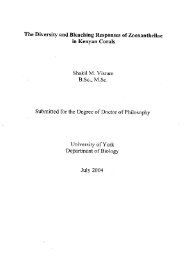
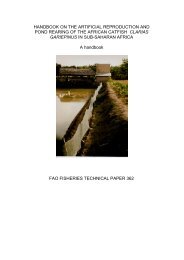

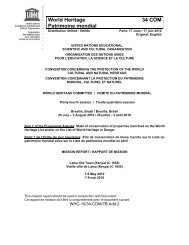
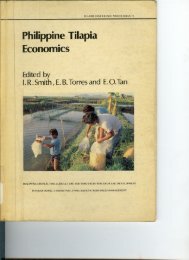
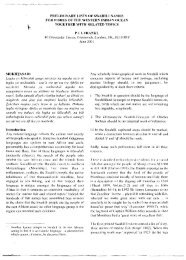

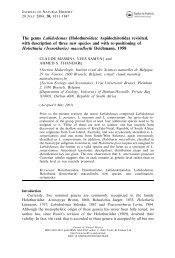
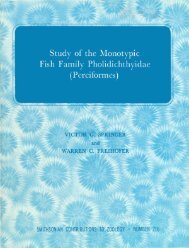
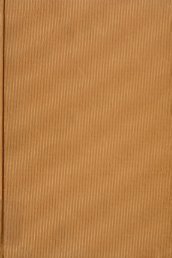
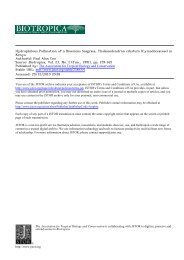
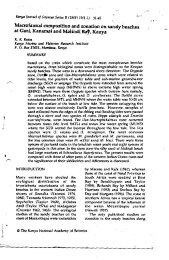
![MSc. Thesis - Lang'at[1].pdf](https://img.yumpu.com/10016993/1/184x260/msc-thesis-langat1pdf.jpg?quality=85)
